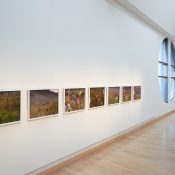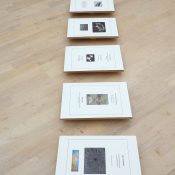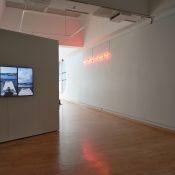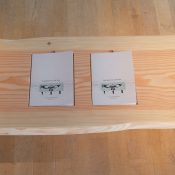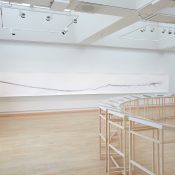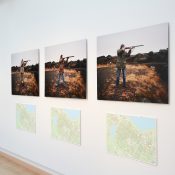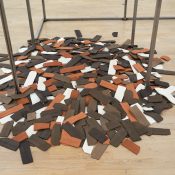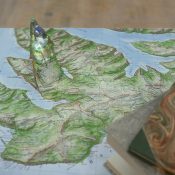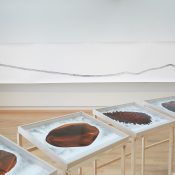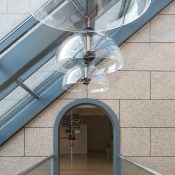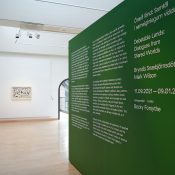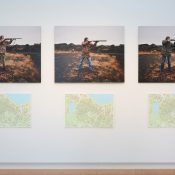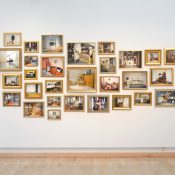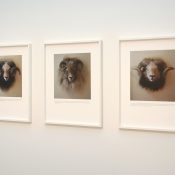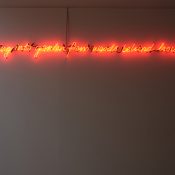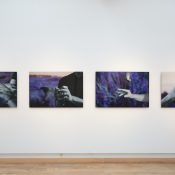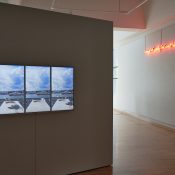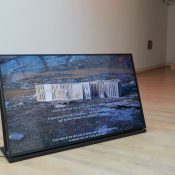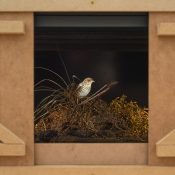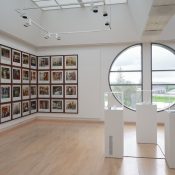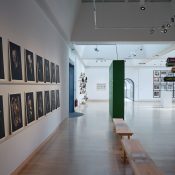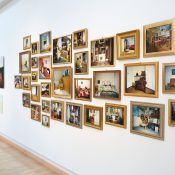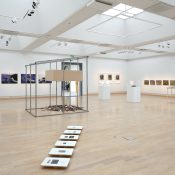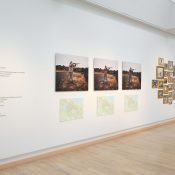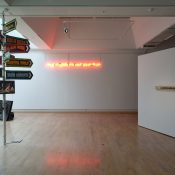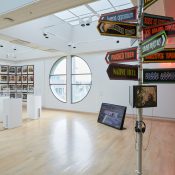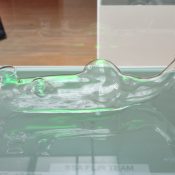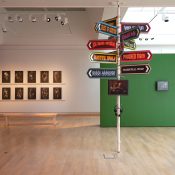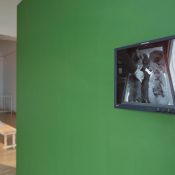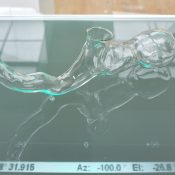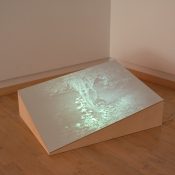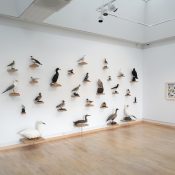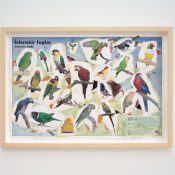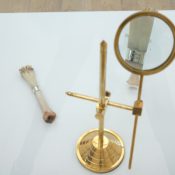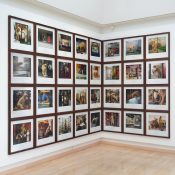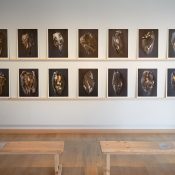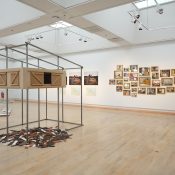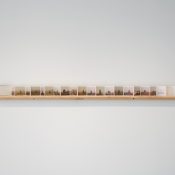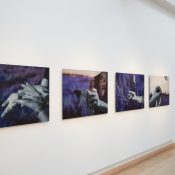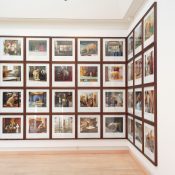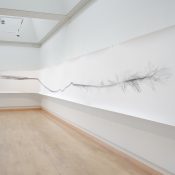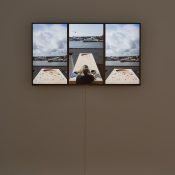- Tálkni Grassworks from Feral Attraction 2016 These photographs, taken by Snæbjörnsdóttir/Wilson from an imagined sheep‘ perspective, were made on the slopes of Mt. Tálkni. In October 2009, a small flock of feral sheep that had lived independently of humans for some decades on Mt. Tálkni, an inaccessible part of the Westfjords, was rounded up by a team of men and dogs from the neighbouring communities. Observations by local farmers suggested that these sheep possessed some physiological adaptations, including a supposed increase in leg length. Nineteen sheep were caught but five perished as they fell from the towering cliffs. All those captured were taken to slaughter immediately and information concerning their physical changes lost in the process. The incident, and subsequently this work, serve to highlight tensions that surface when our will to categorise and contain meets the will of domestic animals who transgress the invisible and unspoken boundaries that separate landscapes of domestication and wildness.
- A Safe Passage | 2009 Photographs with text A Safe Passage is in part a response to a (2007) work by Martha Rosler, Kassel Gardens (from the Perspective of a Mole). Rather than pursuing ideas of human memory and haunting, it imagines the transit of a mole from the UK (where it is regarded as a pest, fit only to be trapped and killed), to Germany, where it is a protected species. Along the way, the artists consider those disparate means by which moles are persecuted, along with speculations regarding their experience and ontology through the lenses of geology, architecture, transit systems and burial rites.
- You Must Carry Me Now (detail) | 2014 Custom-made bench with inlays/books
- (a)fly 2006 Survey (wall text), shooters (photographs on aluminium) and shot maps (on board and with shotgun pellets) (a)fly is founded on a survey that mapped domestic pets within Reykjavik city centre. Four ptarmigan hunters were invited to turn their shotguns on maps at a distance of 50 metres, thereby randomly selecting multiple, specific residential properties within Reykjavík 101. The owners of these properties were contacted and from this, pet owners and animal-dwellings in the area were identified and then photographed. By examining the habitat or dwellings chosen by the pets themselves, or in some cases constructed by their owners, Snæbjörnsdóttir/Wilson offer new and contradictory perspectives on established classification systems and controversially shared environmental relationships – reframing the human-animal exchange.
- Elevation #4: flood/wave/flood 2019 Steel, wood, Pepper’s ghost/3D video, grasses, ceramic tiles The ceramic tiles each carry the common name of one species of flora, fauna, fish, crustacean, mollusc, insect or bird which together make up the ecosystem of the Rhode Island saltmarsh environment – the breeding ground for the soon-to-be-extinct saltmarsh sparrow. By examining the plight of saltmarsh sparrows, who live and breed exclusively in the narrow and increasingly depleted marshlands along the eastern seaboard of the US, Snæbjörnsdóttir/Wilson emphasise the wider issue of human/environmental relations, interdependency and pending extinction. This particular species, it is thought, will be extinct by 2050, because their homeland saltmarshes are among the most vulnerable in the US, due to their low elevation and the rate of rising sea-level in the Northeast. The birds’ nesting cycle lasts around 23 to 24 days – just a few days less than the 28-day tidal cycle influenced by the moon’s gravity. With rising tides more frequent, the 28-day window is lost and eggs will either float away or the chicks drown. Further to that, from inshore, landfilling for development threatens the birds’ survival – and that of the flora and habitat in the area. The ceramic tiles in this work together carry the names of this and all other recorded species of flora and fauna which make up the Rhode Island saltmarsh sparrow breeding environment.
- Feral Attraction – Erasure Projection, maps, books, vitrine In this work, a looped video image is projected onto a map of the Tálkni peninsula. It shows a sheep being sheared. On completion of the process, the sheep struggles from the shearer’s grasp and disappears from the edge of the map. In October 2009, a small flock of feral sheep that had lived independently of humans for some decades on Mt. Tálkni, an inaccessible part of the Westfjords, was rounded up by a team of men and dogs from the neighbouring communities. Observations by local farmers suggested that these sheep possessed some physiological adaptations, including a supposed increase in leg length. Nineteen sheep were caught but five perished as they fell from the towering cliffs. All those captured were taken to slaughter immediately and information concerning their physical changes lost in the process. The incident, and subsequently this work, serve to highlight tensions that surface when our will to categorise and contain meets the will of domestic animals who transgress the invisible and unspoken boundaries that separate landscapes of domestication and wildness.
- Uncertainty in the City – Audio work 2010 100 interviews concerning human-animal encounters. Collected during 2009–2010, the artists took their modified caravan out in the field and into communities in Cumbria, inviting individuals to share stories and opinions of their personal animal encounters. Radio Animal shares these human/animal narratives from in and around human spaces. As Snæbjörnsdóttir/Wilson have written: “We may mow the lawn and weed the borders but things beyond our control continually arrive and depart, through hedges and fences, across and below the surface of the soil and grass – and by air inhabit or visit the trees and flowers. Some are welcome, some are not, and some are a source of vexation and perplexity. In an unthinking way we would often rather be without that which perplexes or bothers us.”
- Pet Environs – (a)fly – flug(a) 2006 33 photographs of domestic interiors, depicting the sites chosen by or assigned to pet animals – assorted gilt frames (a)fly is founded on a survey that mapped domestic pets within Reykjavik city centre. Four ptarmigan hunters were invited to turn their shotguns on maps at a distance of 50 metres, thereby randomly selecting multiple, specific residential properties within Reykjavík 101. The owners of these properties were contacted and from this, pet owners and animal-dwellings in the area were identified and then photographed. By examining the habitat or dwellings chosen by the pets themselves, or in some cases constructed by their owners, Snæbjörnsdóttir/Wilson offer new and contradictory perspectives on established classification systems and controversially shared environmental relationships – reframing the human-animal exchange.
- Feral Attraction (three preserved heads) 2016 In October 2009, a small flock of feral sheep that had lived independently of humans for some decades on Mt. Tálkni, an inaccessible part of the Westfjords, was rounded up by a team of men and dogs from the neighbouring communities. Observations by local farmers suggested that these sheep possessed some physiological adaptations, including a supposed increase in leg length. Nineteen sheep were caught but five perished as they fell from the towering cliffs. All those captured were taken to slaughter immediately and information concerning their physical changes lost in the process. The incident, and subsequently this work, serve to highlight tensions that surface when our will to categorise and contain meets the will of domestic animals who transgress the invisible and unspoken boundaries that separate landscapes of domestication and wildness.
- ‘coming into garden from woods behind house’ is one nervous extract from the Fox Reports, precisely as noted by the receiving pest control officer. The work is .from Uncertainty in the City 2008–2010. Initiated as research on the animals who choose to reside in or move across the borders and thresholds of human homes and gardens, Snæbjörnsdóttir/Wilson focus here on those whose activity, for the most part, is beyond human control, and about whose presence we are often ambivalent. They explored the questions: What is a pest? What is the relationship between fear or discomfort and a lack of control in this context? What are the inconsistencies in our responses to nature within our locality and the reasons behind such contradictions? And what is it about ourselves that begins to be revealed by the recognition of outsiders in our midst? Their findings reveal speculations on the different anxieties, limits of tolerance, unplanned disturbances and the desire for control we seek over wildlife, encountered in urban environments; how ideas concerning human-animal contact, encounters and cohabitation, shift according to their proximity to our homes.
- Elevation #1: escape/release/escape 1-4 from The Only Show in Town | 2019 photographs/diasec By examining the plight of saltmarsh sparrows, who live and breed exclusively in the narrow and increasingly depleted marshlands along the eastern seaboard of the US, Snæbjörnsdóttir/Wilson emphasise the wider issue of human/environmental relations, interdependency and pending extinction. This particular species, it is thought, will be extinct by 2050, because their homeland saltmarshes are among the most vulnerable in the US, due to their low elevation and the rate of rising sea-level in the Northeast. The birds’ nesting cycle lasts around 23 to 24 days – just a few days less than the 28-day tidal cycle influenced by the moon’s gravity. With rising tides more frequent, the 28-day window is lost and eggs will either float away or the chicks drown. Further to that, from inshore, landfilling for development threatens the birds’ survival – and that of the flora and habitat in the area. The ceramic tiles in this work together carry the names of this and all other recorded species of flora and fauna which make up the Rhode Island saltmarsh sparrow breeding environment.
- White Noise 2001 Video (53:00) A text-based account of the artists’ five-day journey on foot through unfamiliar, uninhabited and possibly dangerous territory in Greenland, overlaying an image of a Greenlandic sled dog standing guard outside a makeshift wooden pen. Upon returning from the disorienting hike, each artist wrote these descriptive narratives, diarising their specific responses to the events along the way – to getting lost in the landscape, their thoughts, anxieties, expressions of wonder and even dreams, sequenced in the order they occurred. Though the beginning and end of both accounts are synchronised, the relative significance of the events to each artist and the short phrasing of the extracts disrupt the narrative sequence and emphasise the memory-based, dream-like differences of their individual experiences. Snæbjörnsdóttir/Wilson’s long enduring interest in human/animal relationships was sparked around this time, following their observations of sled dog colonies in the Arctic, more specifically, the fluctuating spectrum upon which the pack dogs exist in the north – from occasional companions and (rarely), pets, to working animals, barely removed
- Elevation #4: flood/wave/flood | 2019 – from The Only Show in Town Steel, wood, Pepper’s ghost/3D video, grasses, ceramic tiles By examining the plight of saltmarsh sparrows, who live and breed exclusively in the narrow and increasingly depleted marshlands along the eastern seaboard of the US, Snæbjörnsdóttir/Wilson emphasise the wider issue of human/environmental relations, interdependency and pending extinction. This particular species, it is thought, will be extinct by 2050, because their homeland saltmarshes are among the most vulnerable in the US, due to their low elevation and the rate of rising sea-level in the Northeast. The birds’ nesting cycle lasts around 23 to 24 days – just a few days less than the 28-day tidal cycle influenced by the moon’s gravity. With rising tides more frequent, the 28-day window is lost and eggs will either float away or the chicks drown. Further to that, from inshore, landfilling for development threatens the birds’ survival – and that of the flora and habitat in the area. The ceramic tiles in this work together carry the names of this and all other recorded species of flora and fauna which make up the Rhode Island saltmarsh sparrow breeding environment.
- Gallery view: You Must Carry Me Now, Íslenskir Fuglar, I’m Not There…
- (a)fly / flug(a) 2006 (a)fly is founded on a survey that mapped domestic pets within Reykjavik city centre. Four ptarmigan hunters were invited to turn their shotguns on maps at a distance of 50 metres, thereby randomly selecting multiple, specific residential properties within Reykjavík 101. The owners of these properties were contacted and from this, pet owners and animal-dwellings in the area were identified and then photographed. By examining the habitat or dwellings chosen by the pets themselves, or in some cases constructed by their owners, Snæbjörnsdóttir/Wilson offer new and contradictory perspectives on established classification systems and controversially shared environmental relationships – reframing the human-animal exchange.
- Gallery view: The Only Show in Town, Feral Attraction…
- (a)fly / flug(a) Survey, Shooters, Maps, Pet Environs 2006 (a)fly is founded on a survey that mapped domestic pets within Reykjavik city centre. Four ptarmigan hunters were invited to turn their shotguns on maps at a distance of 50 metres, thereby randomly selecting multiple, specific residential properties within Reykjavík 101. The owners of these properties were contacted and from this, pet owners and animal-dwellings in the area were identified and then photographed. By examining the habitat or dwellings chosen by the pets themselves, or in some cases constructed by their owners, Snæbjörnsdóttir/Wilson offer new and contradictory perspectives on established classification systems and controversially shared environmental relationships – reframing the human-animal exchange.
- Gallery view: nanoq: Matrix, White Noise, I’m Not There, A Dog-Like Story…
- Matrix | 2016 Glass, projection, sound These works grew from the artists’ fascination with polar bear maternity dens, both in their individuality and their ergonomic form. For six years, Snæbjörnsdóttir/Wilson researched different iterations of their denning in the arctic, finding that the outdated, romantic narrative of pristine isolation and barrenness in the northern circumpolar region is misleading. Instead, polar bears share much of this territory in a complex relationship with multiple human populations, industry, tourism and scientific research; meaning that the bears’ dens are often found in close proximity to human sites. The works are scale models of specific, measured polar bear dens in the Alaskan North Slope Borough. Each den maquette sits on a glass screen, carrying projected video surveillance footage of the coastal area, captured using the Oil and Gas industry’s Forward Looking Infra-Red technology to identify, by thermal imaging, the presence of polar bear dens. If detected, ice roads serving the companies must be built or re-routed to a minimum one-mile radius of the den.
- Flatskins 2004 Video (39:47) In Flat Skins, a conversation is conducted in the Australian section of the University of Oxford Natural History Museum collection. Flat skins (the preserved, head and hide with fur) of a variety of small Australian marsupials are taken one-by-one from their storage drawers and passed backwards and forwards between two female pairs of hands. The black and white movie is slowed and silent – the viewers are invited only to conjecture what ventriloquy from these unfortunate animals is being performed.
- Nightvision 2010 Video (23:38) Nightvision was filmed during both day- and night-time in a garden in South Glasgow. During the day, the camera pans the typical urban garden setting, through 360°, taking in the shed, the red swing, the old roller and compost heap. During the night-filming, the camera is fixed on some bushes, a bird table and a hedge. Towards the end of the piece, two pairs of bright, white eyes appear, one after the other and the shadowy forms of animals move from the frame to the centre of the image, beneath the bird table. The foxes stop for a while, their pointed ears visible, side by side. In this place, one preens the other before they both move on into the darkness.
- Íslenskir Fuglar (Icelandic Birds) 2008 Collage: Poster, tape, printed matter The birds depicted in the collage are all the bird species imported to Iceland during the year 2005–2006. In this work, originally commissioned for the exhibition Bye Bye Iceland in Akureyri Art Museum, the artists looked at human ambivalence towards ideas of change, within Icelandic culture. On one hand, humans are conservative and suspicious of the disruption that change inevitably involves. On the other, they are drawn both to novelty and to the practical benefits that new introductions to our lives can bring. The tension suggested here is between what is considered to be manageable and controllable and what is deemed to be too disruptive and problematic; a judgment that is charged with potential miscalculations and incalculable cultural or ecological consequences. The taxidermic bird species in this two-part work are all those featured on a well-loved, Icelandic ornithological poster.
- ‘The Fall – 2009–2010’ | 2016 Sheep leg bones, engraved silver bands, magnifying glass, reports, vitrine Silver bands inserted into and extending two leg-bones, inscribed respectively with the words Tálkni 2009 and Tálkni 2010, the dates when the sheep were herded off the mountain and slaughtered. In October 2009, a small flock of feral sheep that had lived independently of humans for some decades on Mt. Tálkni, an inaccessible part of the Westfjords, was rounded up by a team of men and dogs from the neighbouring communities. Observations by local farmers suggested that these sheep possessed some physiological adaptations, including a supposed increase in leg length. Nineteen sheep were caught but five perished as they fell from the towering cliffs. All those captured were taken to slaughter immediately and information concerning their physical changes lost in the process. The incident, and subsequently this work, serve to highlight tensions that surface when our will to categorise and contain meets the will of domestic animals who transgress the invisible and unspoken boundaries that separate landscapes of domestication and wildness.
- nanoq: flat out and bluesome 2001-2006 Series of 32 photographs from Snæbjörnsdóttir/Wilson’s survey of taxidermied polar bears in the British Isles Collections of Reykjavík Art Museum, Iceland and Nevada Museum of Art, USA Between 2001 and 2006, Snæbjörnsdóttir/Wilson surveyed and photographed taxidermied polar bears in the UK, as found in storage, on display or undergoing restoration. As part of this project, the artists assembled an archive of images of the bears, incorporating the specific provenance of each specimen; their history and, where possible, the date, places and individuals associated with their death or capture. The photographs are a strange and sometimes unsettling documentation of the polar bears in situ, within museum displays, storage environments and both grand and modest, domestic settings. On one hand tragic and melancholic, they also reveal a layer of humour in the often-unnatural positions, conditions and contexts of the bears, as curiosities, captive still within their cultural environments.
- You Must Carry Me Now 2014 14 archival photographs on rag paper, mounted on Kapa, custom-made shelves and benches with accompanying bookwork inset You Must Carry Me Now is a suite of fourteen photographs the artists made of the preserved cadavers of Californian condors, a threatened species they worked with in Grand Canyon, Arizona. The entire species was saved from extinction in 1987 and is maintained on a human life-support system that closely monitors and treats the birds all year round for the otherwise fatal effects of lead-poisoning. As scavengers, the birds feed from discarded gut piles of hunted game. The viscera are contaminated by the fragmentation of the hunters’ lead bullets, causing crop stasis and eventual starvation in the condors. So the two cultures of conservation and hunting meet and compete in sustained tension, both within the crop and over the fate of this species.
- This artist book frames cairns, photographed during the last day of Snæbjörnsdóttir/Wilson’s 10-day expedition through the uninhabited area of Hornstrandir in the Westfjords, Iceland. The concertina folding allows one cairn to follow another across the vast and misty land – a reminder of these makeshift human markers that, in the absence of paths, guided their passage across the terrain. Following the last photographic image and the words, Reykjafjörður, Þaralátursfjörður, Svartaskarð, July 29 1998, the text reads: The last day of a walking expedition in the Westfjords, Iceland. Weather conditions consistently misty. Visibility 10 metres except in the fjords. The largest scale map of the area in existence is 1:100 000. In such conditions, reliance on a compass is imperative although we inevitably would need to rely on something else from time to time.
- The Only Show in Town – Elevation #1 escape/release/escape | 2017–2019 Photographic works (on diasec) By examining the plight of saltmarsh sparrows, who live and breed exclusively in the narrow and increasingly depleted marshlands along the eastern seaboard of the US, Snæbjörnsdóttir/Wilson emphasise the wider issue of human/environmental relations, interdependency and pending extinction. This particular species, it is thought, will be extinct by 2050, because their homeland saltmarshes are among the most vulnerable in the US, due to their low elevation and the rate of rising sea-level in the Northeast. The birds’ nesting cycle lasts around 23 to 24 days – just a few days less than the 28-day tidal cycle influenced by the moon’s gravity. With rising tides more frequent, the 28-day window is lost and eggs will either float away or the chicks drown. Further to that, from inshore, landfilling for development threatens the birds’ survival – and that of the flora and habitat in the area. The ceramic tiles in this work together carry the names of this and all other recorded species of flora and fauna which make up the Rhode Island saltmarsh sparrow breeding environment.
- nanoq: flat out and bluesome 2001-2006 Series of photographs from Snæbjörnsdóttir/Wilson’s survey of taxidermied polar bears in the British Isles Collections of Reykjavík Art Museum, Iceland and Nevada Museum of Art, USA Between 2001 and 2006, Snæbjörnsdóttir/Wilson surveyed and photographed taxidermied polar bears in the UK, as found in storage, on display or undergoing restoration. As part of this project, the artists assembled an archive of images of the bears, incorporating the specific provenance of each specimen; their history and, where possible, the date, places and individuals associated with their death or capture. The photographs are a strange and sometimes unsettling documentation of the polar bears in situ, within museum displays, storage environments and both grand and modest, domestic settings. On one hand tragic and melancholic, they also reveal a layer of humour in the often-unnatural positions, conditions and contexts of the bears, as curiosities, captive still within their cultural environments.
- Searching for Stipa # 1 2017 Photograph assembled from 29 individual Electron Microscope scans of seeds 100:1. Printed on archival paper, 150 x 1400 cm
- Vanishing Point: Where Species Meet | 2011 Performance video (19:00) Vanishing Point: Where Species Meet is a three-channel video work commissioned for the Gothenburg Biennial Pandemonium in 2011 by the curator Sarat Maharaj. The performance-based HD video work documents a meeting between a human and seabirds around a custom-built table at which bread and fish is prepared and shared. The performance took place on the roof of Roda Sten, the main Biennial building, on the waterfront where food at al fresco café and restaurant tables is targeted and seized, on a regular basis, by fearless gulls. Despite the original site-specific setting, Vanishing Point is a critique on the interpretation and legacy of Christian doctrine which together with Cartesian objectivity has detrimentally placed anthropocentrism and human interests at the heart of western conceptions of the world. The artists’ ambition was ultimately to place this work in an ecclesiastical context. In another way, the work references a well-known biblical miracle narrative, in which generosity and sharing are key, but here, rather than situating it entirely in human terms, it extends the generosity across and between species.
photographic documentation by Vigfús Birgisson
